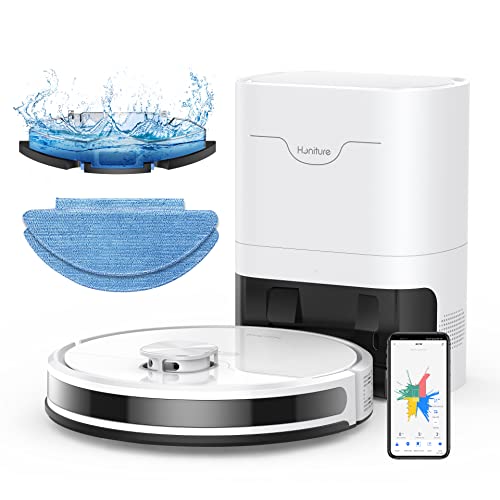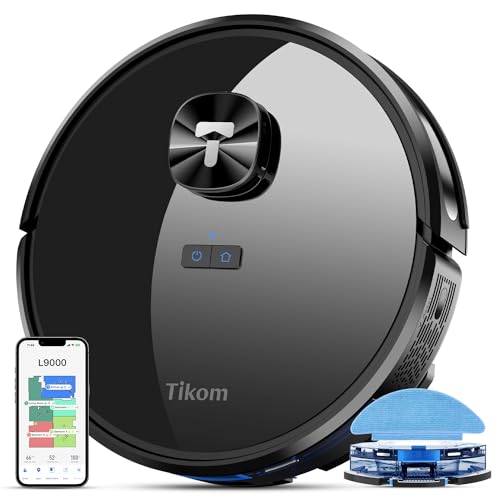Ten Robot Vacuum Lidar Products That Can Help You Live Better
페이지 정보

본문
Lidar Technology Elevates Robot Vacuum Cleaners
The introduction of lidar technology into robot vacuum cleaners has brought into a new era of intelligent and flexible cleaning. Lidar allows navigation, obstacle avoidance and optimized cleaning paths.
 It operates by emitting laser beams and determining the amount of time it takes for them to reflect off objects and return to the sensor. This information is used in order to create a map of the current environment.
It operates by emitting laser beams and determining the amount of time it takes for them to reflect off objects and return to the sensor. This information is used in order to create a map of the current environment.
Accuracy and precision
Lidar technology is a game changer in the world robot vacuum cleaners. It has transformed them to smart and adaptive household companions. They can map out spaces with precision and precision, allowing them to navigate and avoid obstacles without difficulty. lidar sensor robot vacuum is superior to other navigation technologies such as GPS and cameras.
It operates in a straightforward method: The sensors of the robot emit a series of laser beams which reflect off objects in the room. Based on the time it takes for these laser beams to return to the sensor, the robot is able to determine the distance between itself and every object in the room. The robot then creates a precise map of the surrounding area in real-time. This is what gives Lidar-equipped robots like the TESLA Smart Robot Vacuum Laser the incredible abilities to detect obstacles, easily passing through low thresholds and avoid steps without skipping a beat.
Once the robot has an outline of the entire space, it can plan its cleaning route. This results in an efficient, systematic and thorough cleaning. Contrary to this, robots that have non-Lidar navigation typically follow a random cleaning pattern, ping-ponging from one area to the next.
However, as with all technologies lidar systems, the lidar system has its limitations. The lidar system's ability to detect transparent or reflective surfaces such as glass and mirrors is one of the biggest problems. The problem is that these surfaces could be misinterpreted as an obstacle-free zone, which could cause the robot to move through them and possibly damage both the table and the robot itself.
 Another issue that could be a problem is the vulnerability of lidar to side-channel attacks like attacks that exploit audio signals generated by the sensors. These kinds of attacks can be used to intercept private conversations or to gather sensitive personal information such as credit card numbers and passwords.
Another issue that could be a problem is the vulnerability of lidar to side-channel attacks like attacks that exploit audio signals generated by the sensors. These kinds of attacks can be used to intercept private conversations or to gather sensitive personal information such as credit card numbers and passwords.
Overall, lidar vacuum robot-equipped robots are a great option for those who want to increase the cleanliness and comfort of their home. It is important to consider the pros and cons of each model when selecting one that is suited to your particular requirements.
Cleaning Strategies that are Adaptive
A robot vacuum must be able to navigate around obstacles as it moves around your home. Lidar technology has enabled this making robotic vacuum cleaners into intelligent household companions rather than simple cleaning tools. Consumers are increasingly opting for products with advanced navigation capabilities, realizing the importance of efficiency, precision and adaptability.
While many robot vacuums are equipped with obstacle sensors, Lidar adds another layer of precision to the process of navigation. It is able to measure distances by analyzing the amount of time that laser pulses bounce off surfaces and then return to the sensor. With this information, it can change its course in real-time if it encounters the wall or any other obstruction and avoid collisions.
Combined with vision sensors, which can detect reflections or opaque surfaces, Lidar can detect a larger range of textures and objects. It can also be used to help the robot avoid areas that have already been cleaned. This makes sure that every corner of your home is given its due portion.
Other kinds of sensors can improve the navigation capabilities of the vacuum. Cameras can provide visual data that helps the device identify objects and obstacles in its path. This information can assist the robot in navigating safely, avoiding objects like toys or other fragile objects. Cameras can also aid in establishing virtual boundaries, or no-go zones within a room to ensure that the device isn't able to accidentally crash into or damage furniture or other objects.
A robot must also be able recognize patterns on the floor and changes in texture. Vision sensors are used to determine the position of features on surfaces using the combination of cameras and algorithms. The sensors then calculate the floor plan of an area and generate maps that aid the robot in navigating more efficiently.
Other sensors can improve the robot's navigation, such as obstacles detection and cliff sensors. Cliff sensors are an essential safety feature that stops the robot from falling down stairs or other hazardous surfaces. They work by detecting infrared light, which is reflective off of obstacles and is recognized by the vac's receiver. Infrared signals are utilized to detect obstacles in order to identify obstacles in the ground. These signals are transmitted by the bumpers of the robot and trigger the vacuum to steer away from the object, avoiding the risk.
Mapping and Memory
When it comes time to determine the performance of a robot, cleaning-performance tests that are performed in a straight line only tell a part of the story. How the robot maneuvers around your space and plans its cleaning routes is important. Many buyers opt for a robot that has mapping capabilities that use Light Detection And Ranging (lidar).
Lidar-enabled robotics employ spinning laser sensors to scan their surroundings and create digital maps of the room's layout. This allows them to identify walls, furniture, and other objects, and also determine their distance from the robot. The maps can then be used to plan more efficient cleaning routes.
These robots can create detailed maps for a single level or a multi-level house. They are also able to adapt to dynamic environments, such as furniture moving or temporary obstacles. They can also identify many different surfaces and objects including floorings, carpets, tiles, and more. They might have difficulty recognizing dirt, dust, or other small particles.
Lidar navigation could cut down the amount of time needed for robots to complete their task. This is because it allows more precise obstacle detection and navigation, which eventually means shorter run times. A more precise map could also lead to less redundant work and redundancy which in turn will reduce the running expenses.
Lidar is not the only mapping technology that is available in robotic vacuums, though it is among the most advanced. Many models use the combination of technologies, including CV-SLAM (ceiling vision-based simultaneous location and mapping) and an upwards-facing camera to sense their environment. These systems are able to overcome the limitations of accelerometer-based mapping and gyroscopes that are unable to measure height or the presence of obstacles that are narrow like bookcases.
Some robotic vacuums come with an internal memory that can recall the layout of your home which makes them easier to use without relying on remote control. In certain cases, these systems can even identify recurring obstacles and automatically adjust to prevent them from happening again. This is especially helpful for pet owners. messes that are difficult to differentiate from dirt and debris with sensor data.
Integration with Smart Home Ecosystems
Modern smart vacuum robots equipped with Lidar navigation systems are able to seamlessly integrate into the ecosystems of your home. They can communicate with connected devices, such as your home security system or smart bulbs. They can also utilize data analytics to continuously improve their performance by optimizing cleaning paths, and adapting to changes in the environment. They can also use voice commands to allow you to use them hands-free, without needing your attention.
It lets them follow cleaning routes that are designed for space and cover every area of a room efficiently, with a minimum of redundant movement. This reduces time and battery power, and helps ensure that every inch of your living space is cleaned thoroughly.
In contrast to models in budget that rely on the old bump-and-move method of navigation, lidar robot navigation-based robots are not wasting time. This is due to the fact that they don't use up energy by moving ever so slight to the left or right to navigate around obstacles as these robots defaultly use their traditional bump sensor. Instead, they avoid obstacles with their precise mapping capabilities, making them more efficient than traditional robotic vacuums.
Lidar-based sensors are more precise than other sensor technologies, such as ultrasonic and infrared sensors. Robots can avoid navigating over furniture or objects several times, which means less suction. They are also more accurate than the mapping provided by cameras which may be difficult to navigate in dense areas and may require a lot of setting up and calibration.
Furthermore, Lidar Product-based systems are able to connect with your home's smart devices and platforms which makes them simple to control with AI assistants like Alexa or Google Assistant. This lets you define certain rooms for the robot to clean or set up virtual boundaries preventing your robot from accessing certain areas of the home.
A vacuum cleaner with Lidar navigation is the best option to help you clean your house in a reliable and efficient manner. You'll pay a little more for one that has this feature but you'll get most value from your vacuum cleaner and be equipped to use it efficiently without manual intervention.
The introduction of lidar technology into robot vacuum cleaners has brought into a new era of intelligent and flexible cleaning. Lidar allows navigation, obstacle avoidance and optimized cleaning paths.
 It operates by emitting laser beams and determining the amount of time it takes for them to reflect off objects and return to the sensor. This information is used in order to create a map of the current environment.
It operates by emitting laser beams and determining the amount of time it takes for them to reflect off objects and return to the sensor. This information is used in order to create a map of the current environment.Accuracy and precision
Lidar technology is a game changer in the world robot vacuum cleaners. It has transformed them to smart and adaptive household companions. They can map out spaces with precision and precision, allowing them to navigate and avoid obstacles without difficulty. lidar sensor robot vacuum is superior to other navigation technologies such as GPS and cameras.
It operates in a straightforward method: The sensors of the robot emit a series of laser beams which reflect off objects in the room. Based on the time it takes for these laser beams to return to the sensor, the robot is able to determine the distance between itself and every object in the room. The robot then creates a precise map of the surrounding area in real-time. This is what gives Lidar-equipped robots like the TESLA Smart Robot Vacuum Laser the incredible abilities to detect obstacles, easily passing through low thresholds and avoid steps without skipping a beat.
Once the robot has an outline of the entire space, it can plan its cleaning route. This results in an efficient, systematic and thorough cleaning. Contrary to this, robots that have non-Lidar navigation typically follow a random cleaning pattern, ping-ponging from one area to the next.
However, as with all technologies lidar systems, the lidar system has its limitations. The lidar system's ability to detect transparent or reflective surfaces such as glass and mirrors is one of the biggest problems. The problem is that these surfaces could be misinterpreted as an obstacle-free zone, which could cause the robot to move through them and possibly damage both the table and the robot itself.
 Another issue that could be a problem is the vulnerability of lidar to side-channel attacks like attacks that exploit audio signals generated by the sensors. These kinds of attacks can be used to intercept private conversations or to gather sensitive personal information such as credit card numbers and passwords.
Another issue that could be a problem is the vulnerability of lidar to side-channel attacks like attacks that exploit audio signals generated by the sensors. These kinds of attacks can be used to intercept private conversations or to gather sensitive personal information such as credit card numbers and passwords.Overall, lidar vacuum robot-equipped robots are a great option for those who want to increase the cleanliness and comfort of their home. It is important to consider the pros and cons of each model when selecting one that is suited to your particular requirements.
Cleaning Strategies that are Adaptive
A robot vacuum must be able to navigate around obstacles as it moves around your home. Lidar technology has enabled this making robotic vacuum cleaners into intelligent household companions rather than simple cleaning tools. Consumers are increasingly opting for products with advanced navigation capabilities, realizing the importance of efficiency, precision and adaptability.
While many robot vacuums are equipped with obstacle sensors, Lidar adds another layer of precision to the process of navigation. It is able to measure distances by analyzing the amount of time that laser pulses bounce off surfaces and then return to the sensor. With this information, it can change its course in real-time if it encounters the wall or any other obstruction and avoid collisions.
Combined with vision sensors, which can detect reflections or opaque surfaces, Lidar can detect a larger range of textures and objects. It can also be used to help the robot avoid areas that have already been cleaned. This makes sure that every corner of your home is given its due portion.
Other kinds of sensors can improve the navigation capabilities of the vacuum. Cameras can provide visual data that helps the device identify objects and obstacles in its path. This information can assist the robot in navigating safely, avoiding objects like toys or other fragile objects. Cameras can also aid in establishing virtual boundaries, or no-go zones within a room to ensure that the device isn't able to accidentally crash into or damage furniture or other objects.
A robot must also be able recognize patterns on the floor and changes in texture. Vision sensors are used to determine the position of features on surfaces using the combination of cameras and algorithms. The sensors then calculate the floor plan of an area and generate maps that aid the robot in navigating more efficiently.
Other sensors can improve the robot's navigation, such as obstacles detection and cliff sensors. Cliff sensors are an essential safety feature that stops the robot from falling down stairs or other hazardous surfaces. They work by detecting infrared light, which is reflective off of obstacles and is recognized by the vac's receiver. Infrared signals are utilized to detect obstacles in order to identify obstacles in the ground. These signals are transmitted by the bumpers of the robot and trigger the vacuum to steer away from the object, avoiding the risk.
Mapping and Memory
When it comes time to determine the performance of a robot, cleaning-performance tests that are performed in a straight line only tell a part of the story. How the robot maneuvers around your space and plans its cleaning routes is important. Many buyers opt for a robot that has mapping capabilities that use Light Detection And Ranging (lidar).
Lidar-enabled robotics employ spinning laser sensors to scan their surroundings and create digital maps of the room's layout. This allows them to identify walls, furniture, and other objects, and also determine their distance from the robot. The maps can then be used to plan more efficient cleaning routes.
These robots can create detailed maps for a single level or a multi-level house. They are also able to adapt to dynamic environments, such as furniture moving or temporary obstacles. They can also identify many different surfaces and objects including floorings, carpets, tiles, and more. They might have difficulty recognizing dirt, dust, or other small particles.
Lidar navigation could cut down the amount of time needed for robots to complete their task. This is because it allows more precise obstacle detection and navigation, which eventually means shorter run times. A more precise map could also lead to less redundant work and redundancy which in turn will reduce the running expenses.
Lidar is not the only mapping technology that is available in robotic vacuums, though it is among the most advanced. Many models use the combination of technologies, including CV-SLAM (ceiling vision-based simultaneous location and mapping) and an upwards-facing camera to sense their environment. These systems are able to overcome the limitations of accelerometer-based mapping and gyroscopes that are unable to measure height or the presence of obstacles that are narrow like bookcases.
Some robotic vacuums come with an internal memory that can recall the layout of your home which makes them easier to use without relying on remote control. In certain cases, these systems can even identify recurring obstacles and automatically adjust to prevent them from happening again. This is especially helpful for pet owners. messes that are difficult to differentiate from dirt and debris with sensor data.
Integration with Smart Home Ecosystems
Modern smart vacuum robots equipped with Lidar navigation systems are able to seamlessly integrate into the ecosystems of your home. They can communicate with connected devices, such as your home security system or smart bulbs. They can also utilize data analytics to continuously improve their performance by optimizing cleaning paths, and adapting to changes in the environment. They can also use voice commands to allow you to use them hands-free, without needing your attention.
It lets them follow cleaning routes that are designed for space and cover every area of a room efficiently, with a minimum of redundant movement. This reduces time and battery power, and helps ensure that every inch of your living space is cleaned thoroughly.
In contrast to models in budget that rely on the old bump-and-move method of navigation, lidar robot navigation-based robots are not wasting time. This is due to the fact that they don't use up energy by moving ever so slight to the left or right to navigate around obstacles as these robots defaultly use their traditional bump sensor. Instead, they avoid obstacles with their precise mapping capabilities, making them more efficient than traditional robotic vacuums.
Lidar-based sensors are more precise than other sensor technologies, such as ultrasonic and infrared sensors. Robots can avoid navigating over furniture or objects several times, which means less suction. They are also more accurate than the mapping provided by cameras which may be difficult to navigate in dense areas and may require a lot of setting up and calibration.
Furthermore, Lidar Product-based systems are able to connect with your home's smart devices and platforms which makes them simple to control with AI assistants like Alexa or Google Assistant. This lets you define certain rooms for the robot to clean or set up virtual boundaries preventing your robot from accessing certain areas of the home.
A vacuum cleaner with Lidar navigation is the best option to help you clean your house in a reliable and efficient manner. You'll pay a little more for one that has this feature but you'll get most value from your vacuum cleaner and be equipped to use it efficiently without manual intervention.
- 이전글How To Outsmart Your Boss On Boot Scooter 24.08.25
- 다음글14 Smart Ways To Spend Your The Remaining Robot Vacuum Best Budget 24.08.25
댓글목록
등록된 댓글이 없습니다.








